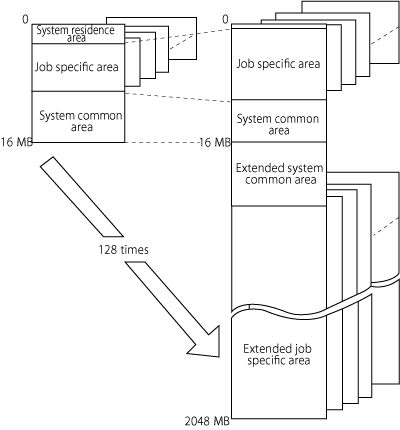The advantage of VOS3 was a multiple virtual storage system that provided an independent 16-MB virtual storage to each job. However, as the sizes of user applications and systems grew, it became necessary to secure a space much larger than 16 megabytes. To meet this requirement, Hitachi added an extended addressing mechanism, which extended the addressing scheme from 24 bits to 31 bits, to the M-280 and M-260 processor groups of the HITAC M series. VOS3/ES1 was the OS that supported this extended addressing mechanism. In VOS3/ES1, the virtual address space per job was expanded by 128 times from 16 megabytes to 2 gigabytes.
Figure 1 shows the expansion of the virtual space to 2 gigabytes.
 Figure 1 "Expansion of the virtual space to 2 gigabytes"
Figure 1 "Expansion of the virtual space to 2 gigabytes"
Hitachi announced VOS3/ES1 in November 1983 and started shipping it in December 1984.
The M-280 and M-260 processor groups had two processor modes: M mode for 24-bit addressing, and M/EA mode to support 24-bit and 31-bit addressing. Table 1 shows the relationship between these hardware modes and the OSs that supported them.
Table 1 Relationship between the processor modes and the OSs that supported them
|
|
OS
|
|
VOS3/ES1
|
VOS3/SP
|
|
CPU
|
M-280 processor group
|
M mode
|
×
|
○
|
|
M/EA mode
|
○
|
×
|
|
M-260 processor group
|
M mode
|
×
|
○
|
|
M/EA mode
|
○
|
×
|
|
M-240 processor group
|
×
|
○
|
In M/EA mode, the OS was capable of simultaneously running 24-bit addressing mode and 31-bit addressing mode. This allowed concurrent execution of an existing program using 24-bit addressing and a new program using 31-bit addressing. As a result, program compatibility was maintained and transition leveling was achieved.
In VOS3/ES1, part of the control program was also moved to the expanded area above 16 megabytes, creating a larger space than was available with the previous model in the area below 16 megabytes. This enabled extension of an existing application program using 24-bit addressing, an increase in the number of terminals and an increase in the number of files..
In addition, because the real storage also used the 31-bit addressing scheme, the real storage was treated in a unified manner and used effectively.
Table 2 shows a list of VOS3-related software products that realize address extension.
Table 2 VOS3-related software products that realized address extension
|
Product name
|
Overview of function
|
|
VOS3/ES1
|
A system product for VOS3.
Realizes a control program function for 31-bit addressing.
|
|
LNK/LD2 EA option
|
Realizes a linkage editor/loader function for 31-bit addressing by being added to LNK/LD2 (linkage editor/loader 2).
|
|
OFORT77 EA option
|
Realizes a FORTRAN program generation function for 31-bit addressing by being added to OFORT77 (optimizing FORTRAN 77).
|
|
DCCM/UEA option
|
Allows part of the DCCMII procedure and table to operate in the extended address area by being added to DCCMII.
|
|
XMAP EA option
|
Realizes generation and control of a map for the extended address area under DCCMII by being added to XMAP.
|


